San Marino

The Block
The sale of postage stamps––which are produced several times a year and sold almost entirely to collectors––is a significant source of income for San Marino, so it seems only fitting that this block was created to resemble a stamp. The design, worked on an assortment of linens by Carolyn Meyer, focuses on the number three, a recurring theme in Sammarinese culture.
The country’s terrain is dominated by tri-peaked Mount Titano, featuring three constructed towers; the coat of arms depicts three towers on three peaks; the city is enclosed by three walls, the interior of the Basilica del Santo contains three aisles; there are three towers on the Statue of Liberty’s crown; and three roses, trees or wheels are often featured on national stamps. Two triangles––each featuring an embroidered representation of a prominent Sammarinese structure––are superimposed on a linen background to create the image of Mount Titano’s three peaks. The larger triangle depicts La Guaita (or La Rocca), the mountain’s first tower, which dates back to the 11th century and was historically used as a guard tower. The second shows La Palazzo Pubblico (The Government Palace), believed to have been built between 1380 and 1392. A third triangle consists of an authentic, laminated Sammarinese stamp. Scalloped edging, similar to that on a typical stamp, completes the piece.
Cultural Profile
San Marino, the third smallest country in Europe, is a landlocked state lying in the eastern foothills of the Apennines. One of the planet’s smallest nations, it is also the oldest republic in the world, founded (according to tradition) in 301 A.D. by Saint Marinus, a skilled stonecutter from Dalmatia. He is believed to have taken refuge on tri-peaked Mount Titano, the dominant geographical feature of San Marino upon which the famed Guaita (or La Rocca), Cesta, and Montale towers were built. The population of San Marino is comprised mainly of Sammarinese and Italians, and the official language is Italian.
Most people work on the land or in forestry; however tourism is the foundation of San Marino’s economy, as over three million people visit the country each year. Agriculture, including wine and cheese products, and light industry such as banking, electronics and ceramics are also significant.
Traditional events are very important to the Sammarinese, who are known for flag-waving demonstrations involving skilled men waving huge, hand-painted silk flags––historically used as a means of communication during times of battle––in a series of complicated movements. Crossbow archery is another important aspect of the culture, and has become a competitive sport in which people wearing medieval costumes participate. Music also plays a key role in San Marino; its wordless national anthem is likely the oldest of any country’s. Its festivities––marked by parades, pomp and ceremony––often feature the country’s military band, which has a long and proud history. National crafts include pottery, ceramics and stonework.
People have been coming to Canada from San Marino since 1976, however their numbers remain very small. The 2001 census reports less than twenty Sammarinese currently living here.
Sponsor: Staff of St. Monica’s House, St. Joseph’s Secondary School in memoriam Sarah Meyer
